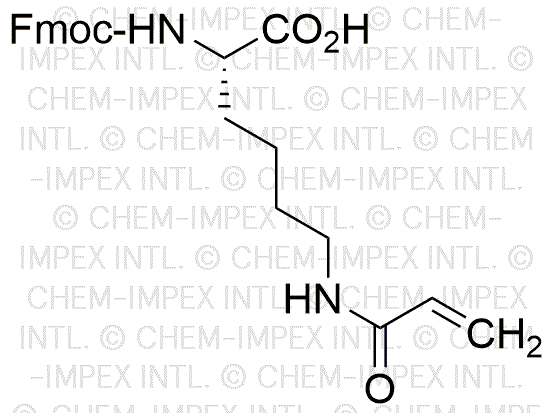Na-Fmoc-Ne-Acryloyl-L-lysine is widely utilized in research focused on:
- Peptide Synthesis: This compound serves as a valuable building block in the synthesis of peptides, allowing for the introduction of acryloyl groups that can facilitate further modifications and functionalization.
- Bioconjugation: It is used in bioconjugation processes, where it can help link biomolecules to surfaces or other compounds, enhancing the development of targeted drug delivery systems.
- Polymer Chemistry: The acryloyl group enables its incorporation into polymer networks, making it useful in creating hydrogels for applications in tissue engineering and regenerative medicine.
- Fluorescent Labeling: This chemical can be utilized for labeling proteins or other biomolecules, aiding in the visualization and tracking of biological processes in research settings.
- Drug Development: Its unique structure allows for the design of novel therapeutic agents, particularly in the field of cancer research, where targeted delivery and controlled release are crucial.
General Information
Properties
Safety and Regulations
Applications
Na-Fmoc-Ne-Acryloyl-L-lysine is widely utilized in research focused on:
- Peptide Synthesis: This compound serves as a valuable building block in the synthesis of peptides, allowing for the introduction of acryloyl groups that can facilitate further modifications and functionalization.
- Bioconjugation: It is used in bioconjugation processes, where it can help link biomolecules to surfaces or other compounds, enhancing the development of targeted drug delivery systems.
- Polymer Chemistry: The acryloyl group enables its incorporation into polymer networks, making it useful in creating hydrogels for applications in tissue engineering and regenerative medicine.
- Fluorescent Labeling: This chemical can be utilized for labeling proteins or other biomolecules, aiding in the visualization and tracking of biological processes in research settings.
- Drug Development: Its unique structure allows for the design of novel therapeutic agents, particularly in the field of cancer research, where targeted delivery and controlled release are crucial.
Documents
Safety Data Sheets (SDS)
The SDS provides comprehensive safety information on handling, storage, and disposal of the product.
Product Specification (PS)
The PS provides a comprehensive breakdown of the product’s properties, including chemical composition, physical state, purity, and storage requirements. It also details acceptable quality ranges and the product's intended applications.
Certificates of Analysis (COA)
Search for Certificates of Analysis (COA) by entering the products Lot Number. Lot and Batch Numbers can be found on a product’s label following the words ‘Lot’ or ‘Batch’.
*Catalog Number
*Lot Number
Certificates Of Origin (COO)
This COO confirms the country where the product was manufactured, and also details the materials and components used in it and whether it is derived from natural, synthetic, or other specific sources. This certificate may be required for customs, trade, and regulatory compliance.
*Catalog Number
*Lot Number
Safety Data Sheets (SDS)
The SDS provides comprehensive safety information on handling, storage, and disposal of the product.
DownloadProduct Specification (PS)
The PS provides a comprehensive breakdown of the product’s properties, including chemical composition, physical state, purity, and storage requirements. It also details acceptable quality ranges and the product's intended applications.
DownloadCertificates of Analysis (COA)
Search for Certificates of Analysis (COA) by entering the products Lot Number. Lot and Batch Numbers can be found on a product’s label following the words ‘Lot’ or ‘Batch’.
*Catalog Number
*Lot Number
Certificates Of Origin (COO)
This COO confirms the country where the product was manufactured, and also details the materials and components used in it and whether it is derived from natural, synthetic, or other specific sources. This certificate may be required for customs, trade, and regulatory compliance.


